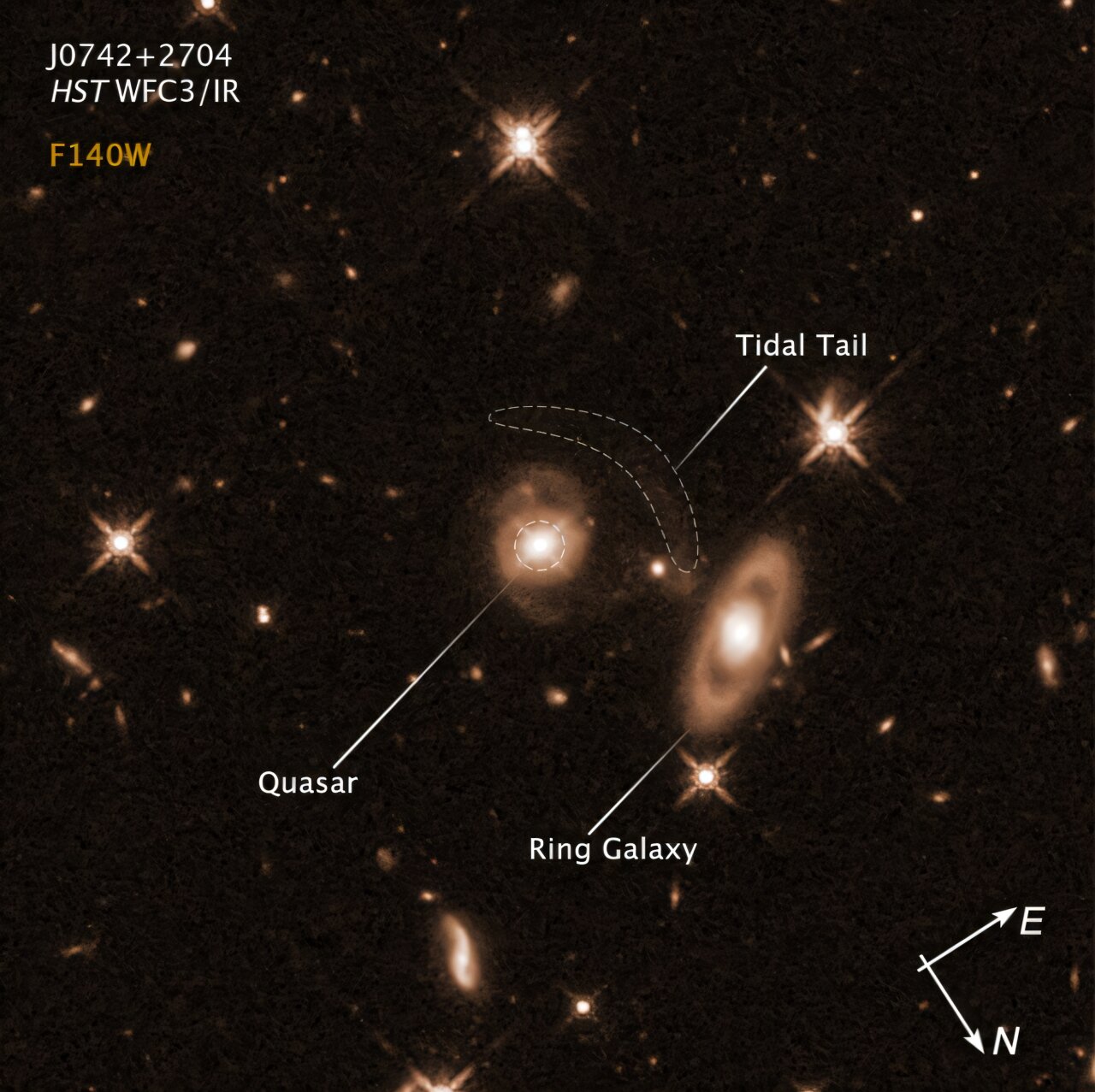The night sky has long been an essential tool for navigation. From guiding early oceanic voyages with the stars to the precise calibrations of modern GPS, celestial objects have provided humans with direction and understanding. Among these, quasars stand out as unique astronomical phenomena now employed as cosmic beacons by the United States Navy. Quasars are distant galaxies powered by supermassive black holes surrounded by disks of intensely hot gas. This gas, swirling at incredible speeds, occasionally expels material in the form of jets, creating one of the most luminous and energetic objects in the universe.
In 2020, scientists discovered newborn jets in several quasars—a groundbreaking finding that expanded our understanding of galaxy evolution and jet formation. Building on this discovery, Olivia Achenbach, an aspiring naval officer and United States Naval Academy student, used NASA’s Hubble Space Telescope to delve deeper into one of these quasars, J0742+2704. Her research revealed unexpected properties that challenge longstanding theories about quasar evolution.
Achenbach described her experience as both exhilarating and surprising. “The biggest surprise was seeing the distinct spiral shape in the Hubble Space Telescope images. At first, I was worried I had made an error,” she admitted. Achenbach’s discovery took place during a brief yet productive four-week internship. What she found has significant implications for understanding quasar-hosting galaxies.
Quasars are typically associated with older, elliptical galaxies—formed after turbulent galaxy mergers that funnel enormous amounts of gas into central black holes. Astronomer Kristina Nyland of the Naval Research Laboratory, who supervised Achenbach, remarked on the novelty of the finding. “It’s extremely rare and exciting to find a quasar-hosting galaxy with spiral arms,” she explained. The black hole in J0742+2704 is massive—over 400 million times the mass of the sun—making its presence in a spiral galaxy even more unusual. Adding to its uniqueness is the presence of young jets, detectable now with modern instruments but invisible two decades ago.
The discovery of such jets in a spiral galaxy adds fuel to a larger debate within the astronomy community about how quasar jets are formed. Historically, many astronomers have posited that major galaxy mergers are the primary trigger for these jets. During such mergers, gas from colliding galaxies heats up and is funneled toward a newly merged central black hole, igniting powerful jets that shoot into space. However, J0742+2704 challenges this assumption, suggesting there may be alternative pathways for jet formation that do not require a disruptive merger.
Despite its spiral structure, the Hubble images of J0742+2704 hint at past interactions with other galaxies. One of its spiral arms appears distorted, forming what may be a tidal tail—a telltale sign of gravitational influence from a nearby galaxy. Nyland explained, “Clearly, there is something interesting going on. While the quasar has not experienced a major disruptive merger, it may be interacting with another galaxy, which is gravitationally tugging at its spiral arm.”
Adding to the intrigue, another nearby galaxy in the Hubble images displays a ring structure. These ring-shaped galaxies are exceedingly rare and often form when a smaller galaxy passes through the center of a spiral galaxy. While the connection between the two galaxies remains to be confirmed through spectroscopy, Nyland sees this configuration as a potential clue. “The ring galaxy near the quasar host galaxy could be an intriguing clue as to what is happening in this system. We may be witnessing the aftermath of the interaction that triggered this young quasar jet,” she suggested.
Far from concluding the story, these findings mark the beginning of a new line of inquiry. Further multi-wavelength analysis of J0742+2704 is planned, utilizing data from NASA’s Chandra X-ray Observatory and the Atacama Large Millimeter/submillimeter Array (ALMA) in Chile. These observations aim to paint a more comprehensive picture of the interactions and processes driving the quasar and its jets.
Achenbach reflected on the evolving nature of such discoveries, emphasizing the importance of persistence in scientific research. “If we looked at this galaxy 20 years, or maybe even a decade ago, we would have seen a fairly average quasar and never known it would eventually be home to newborn jets,” she said. “It goes to show that if you keep searching, you can find something remarkable that you never expected, and it can send you in a whole new direction of discovery.”
Nyland echoed Achenbach’s sentiments, underscoring the potential of such unexpected findings to reshape scientific understanding. These insights are especially valuable not only for astronomy but also for related fields like cosmology and galaxy evolution.
The significance of J0742+2704 lies not just in its immediate implications for quasar formation and galaxy evolution but also in how it represents a broader pattern of scientific discovery. With advanced tools like the Hubble Space Telescope, the Chandra Observatory, and ALMA, astronomers are uncovering details about the universe that were previously hidden. As technology continues to evolve, so too will humanity’s understanding of the cosmos, revealing new mysteries and answering age-old questions about the nature of the universe.
The findings regarding quasar J0742+2704 were presented at the 245th meeting of the American Astronomical Society in National Harbor, Maryland, marking another milestone in the exploration of one of the universe’s most fascinating phenomena.
Think this is important? Spread the knowledge! Share now.
